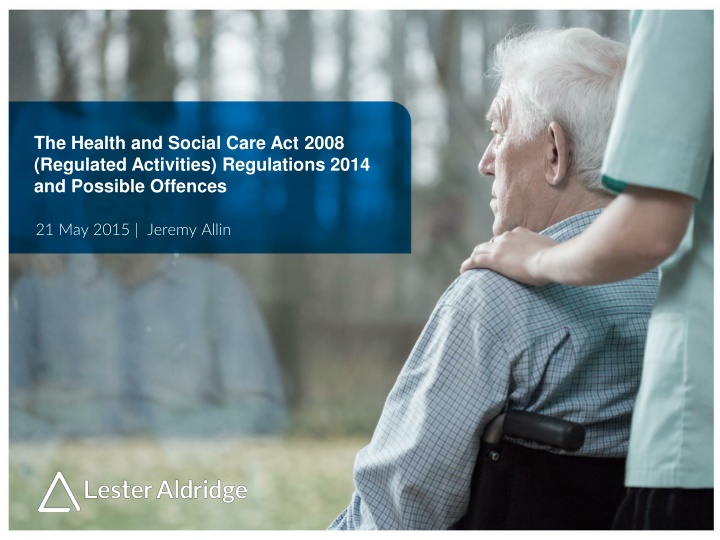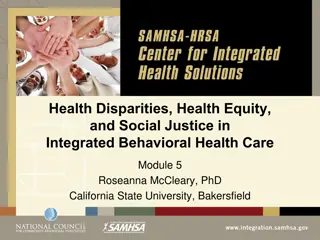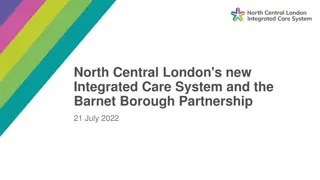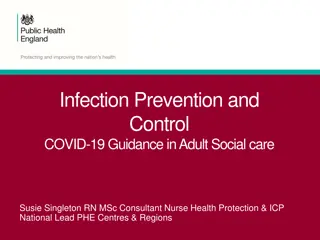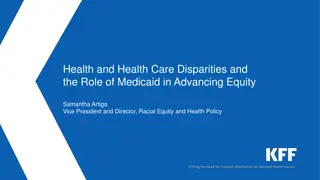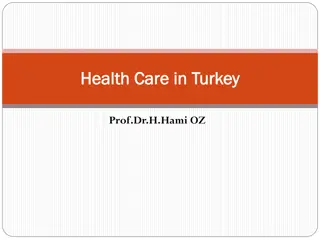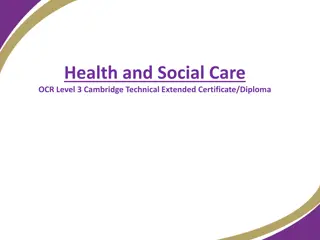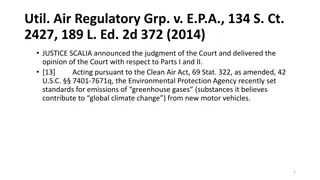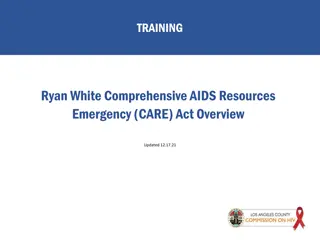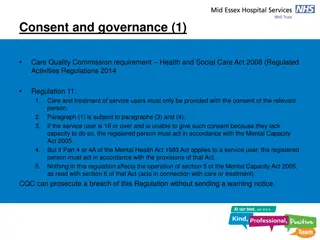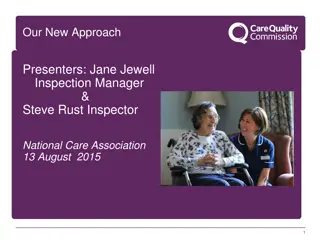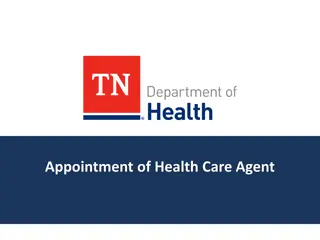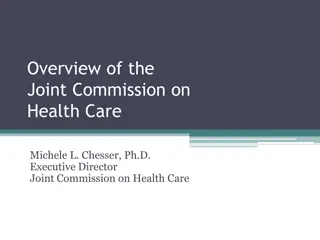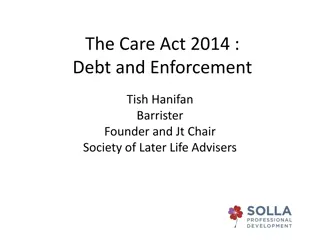Overview of Health and Social Care Act 2008 Regulations
The Health and Social Care Act 2008 introduced new regulations in 2014, including Fundamental Standards, Duty of Candour, and Fit and Proper Persons requirement, empowering CQC to prosecute cases of harm to service users. The Fundamental Standards replaced the Essential Standards, emphasizing person-centered care, dignity, safeguarding, and staff suitability. This comparison highlights the shift towards a more comprehensive and targeted approach to care quality.
Download Presentation

Please find below an Image/Link to download the presentation.
The content on the website is provided AS IS for your information and personal use only. It may not be sold, licensed, or shared on other websites without obtaining consent from the author.If you encounter any issues during the download, it is possible that the publisher has removed the file from their server.
You are allowed to download the files provided on this website for personal or commercial use, subject to the condition that they are used lawfully. All files are the property of their respective owners.
The content on the website is provided AS IS for your information and personal use only. It may not be sold, licensed, or shared on other websites without obtaining consent from the author.
E N D
Presentation Transcript
The Health and Social Care Act 2008 (Regulated Activities) Regulations 2014 and Possible Offences 21 May 2015 | Jeremy Allin
The Health and Social Care Act 2008 (Regulated Activities) Regulations 2014 Replace the 2010 Regulations The following factors are established by the new regulations: Fundamental Standards Duty of Candour Fit and Proper Persons Requirement for Directors Under the regulations, CQC is now able to prosecute cases where someone using a registered service is harmed or is at risk of harm
The Fundamental Standards The Essential Standards in the 2010 regulations have been replaced by the Fundamental Standards under the 2014 Regulations The Fundamental Standards are clearer statements of the standards of care that providers are expected to meet at all times There are also two new regulations: the fit and proper person requirement for directors and a statutory duty of candour The Fundamental Standards come into force for all registered providers on 1 April 2015
Comparison of the old standards and the fundamental standards Current regulations Care and welfare of service users Assessing and monitoring the quality of service provision Safeguarding service users from abuse Cleanliness and infection control Management of medicines Meeting nutritional needs Safety and suitability of premises Safety and suitability of equipment Respecting and involving service users Consent to care and treatment Complaints Records Requirements relating to workers Staffing Supporting workers Cooperating with other providers New regulations Person-centred care Dignity and respect Need for consent Safe care and treatment Safeguarding service users from abuse Meeting nutritional needs Cleanliness, safety and suitability of premises and equipment Receiving and acting on complaints Good governance Staffing Fit and proper persons employed and Fit and proper person requirement for directors Duty of candour Comparison taken from CQC s Guidance for providers on meeting the fundamental standards and on CQC s enforcement powers , July 2014.
Under the 2014 regulations, some of the regulations allow for direct prosecution when the Fundamental Standards are breached When breaches of regulations do not constitute a criminal offence, CQC can enforce the Fundamental Standards using civil powers to impose conditions, suspend or cancel a registration. If providers do not comply with the requirements under the civil powers, they will be committing a criminal offence and could be prosecuted
Duty of Candour Regulation 20 Aims to ensure that providers are open and transparent with service users and other relevant persons (those acting lawfully on their behalf) regarding their care and treatment Introduces a legal requirement requiring all health and adult social care providers registered with CQC to be open with people if things go wrong CQC will be able to take enforcement action if this requirement is breached Came into force for NHS bodies on 27 November 2014, and will apply to all care providers from 1 April 2015
Key Definitions Openness Enabling concerns and complaints to be raised freely without fear and questions asked to be answered. Transparency Allowing information about the truth about performance and outcomes to be shared with staff, patients, the public and regulators. Candour Any patient harmed by the provision of a healthcare service is informed of the fact and an appropriate remedy offered, regardless of whether a complaint has been made or a question asked about it.
In order to comply with Regulation 20, providers must: Act in an open and transparent way regarding care and treatment provided to service users Inform the person as soon as reasonably practicable if something goes wrong, and provide support Provide an account of the incident which is true of all the facts the provider is aware of Advise on any further enquiries Offer an apology
The Health and Social Care Act 2008 (Regulated Activities) (Amendment) Regulations 2015 These regulations introduce Regulation 20A. This requires providers to display their CQC rating (Outstanding, Good, Requires Improvement or Inadequate) Applies to all providers when they have received a CQC rating The rating must be displayed legibly and conspicuously at the premises and on the website Failing to do so will mean that CQC can prosecute, and they can move directly to prosecution without first serving a warning notice Comes into force 1 April 2015
The display of the CQC rating must include: The CQC logo The name of the service The overall performance rating The rating for each of the five key questions and the performance in relation to particular premises or activities CQC s website address and the location on the website where the ratings and assessment of the provider can be found The date the inspection report was published
Fit and Proper Persons Requirement Regulation 5 Aims to ensure that directors are fit and proper to take on responsibility for the overall quality and safety of the care a service provides, and that it meets the requirements under the Health and Social Care Act 2008 (Regulated Activities) Regulations 2014 Applies to directors: executive, non-executive, permanent, interim and associate positions, irrespective of their voting rights Came into force for health service bodies on 27 November 2014, and will apply to all other providers from 1 April 2015
In order to comply with Regulation 5, providers must: Make every reasonable effort to assure themselves of the suitability of their directors by all means available Provide evidence that suitable systems are in place to ensure all new and existing directors are fit for the role Ensure directors are of good character and that no appointments meet any of the unfitness criteria: Bankruptcy, insolvency, appearing on barred lists, being prohibited from holding directorships, involved in a serious misconduct, mismanagement of failure of care If someone no longer meets the requirement, inform the regulator
Breaching Regulation 5 If someone who does not meet the FPPR is appointed, or is already in place, this will be a breach of Regulation 5. Evidence of this breach could be: There are no proper systems in place for a provider to make the assessments required A director is unfit on a mandatory ground, for example bankruptcy, insolvency etc A provider receives information concerning the fitness of a director, and makes a decision regarding their fitness that is not one a reasonable person would make CQC can take enforcement action if a breach of FPPR occurs
Offences CQC will be able to bring prosecutions for breaches under The Health and Social Care Act 2008 (Regulated Activities) Regulations 2014 and The Health and Social Care Act 2008 (Regulated Activities) (Amendment) Regulations 2015 Some of the new regulations have offences attached, and CQC will be able to bring prosecutions if these regulations are breached. For regulations they cannot prosecute against, CQC may use other civil actions as set out in their enforcement policy
CQC may prosecute breaches of the following regulations directly without first issuing a Warning Notice: Need for consent Regulation 11 Regulation 16(3) Receiving and acting on complaints Regulation 17(3) Good governance Duty of candour Regulation 20 (2) and (3) Regulation 20A Requirement as to display of performance assessments A defence to these offences is available where the registered persons took all reasonable steps and acted with all due diligence (Regulation 22(4))
CQC can prosecute for the following offences, but only if the breach of the regulation results in people who use services being exposed to avoidable harm, a significant risk of such harm occurring or suffering a loss of money or property as a result of theft, misuse or misappropriation: Safe care and treatment Regulation 12 Safeguarding service users from abuse and improper treatment Regulation 13 (1) to (4) Meeting nutritional and hydration needs Regulation 14 For breaches of the remaining regulations not listed on these slides, CQC can take regulatory action other than prosecution.
Criminal Justice & Courts Act 2015 S.20 .ill treatment or wilful neglect: care worker offence S.21 .ill treatment or wilful neglect: care provider offence
S.21 Ill-treatment or wilful neglect: care provider offence (1) A care provider commits an offence if- (a) an individual who has the care of another individual by virtue of being part of the care provider s arrangements ill-treats or wilfully neglects that individual (b) the care provider s activities are managed or organised in a way which amounts to a gross breach of a relevant duty of care owed by the care provider to the individual who is ill-treated or neglected, and (c) in the absence of the breach, the ill-treatment or wilful neglect would not have occurred or would have been less likely to occur
Care Provider means- a) a body corporate or unincorporated association which provides or arranges for the provision of - a) health care for an adult or child, other than excluded health b) social care for an adult, or care, or b) an individual who provides such care and employs, or has otherwise made arrangements with, other persons to assist him or her in providing such care.
Penalties: Fine Remedial order Publicity order
Health and Safety Incidents Transfer of responsibility from the Health and Safety Executive to CQC in deciding whether regulatory action will be taken in relation to reported incidents of health and safety involving people using services regulated by CQC It will fall to CQC to investigate incidents such as deaths of service users following poor treatment, physical restraint, choking and falls A recently published Memorandum of Understanding between CQC, HSE and local authorities aims to ensure effective, co-ordinated and comprehensive regulation of health and safety Comes into force from 1 April 2015
Jeremy Allin| Consultant Jeremy is a senior litigator of wide experience, but now mainly concentrates on health and community care and employment law. With a specialism in healthcare, Jeremy advises on breach of contract; inquests; regulatory disputes and care home closures; First Tier Tribunal cases; safeguarding investigations; human rights issues; right of life and deprivation of liberty. 01202 786197 jeremy.allin@LA-law.com
